Interesting Facts About Mali You Never Knew
Did you know Mali's history dates back to 10,000 BC, with complex prehistoric societies? The country's ancient Mali Empire, lasting from the 1200s to 1600s, was once a powerhouse of wealth and knowledge. Timbuktu, a renowned center of trade and education, houses invaluable historical manuscripts. Mali boasts architectural wonders like the Great Mosque of Djenné, the world's largest mud-brick building. The country's diverse landscape includes the Niger River, Mount Hombori Tondo, and the Sahara Desert. With a rich musical heritage and cultural mosaic of over 12 national languages, Mali's fascinating aspects extend far beyond these initial facts.
This post may contain affiliate links. If you make a purchase through these links, I may earn a commission at no additional cost to you. Additionally, portions of this post may be generated using artificial intelligence (AI) technology. While we strive for accuracy, please be aware that AI-generated content may not always be perfect and should be fact-checked when necessary.
The Spatula Scoops
- Mali's history dates back to 10,000 BC, with the Sahara Desert once being a fertile region supporting diverse wildlife.
- The Great Mosque of Djenné is the world's largest mud-brick building and a UNESCO World Heritage Site.
- Mansa Musa, a Malian ruler, is considered one of history's wealthiest individuals with an estimated wealth of $400 billion today.
- Mali's musical heritage includes unique genres like Wassoulou and Tuareg desert blues, but faces risks due to regional instability.
- The country boasts remarkable geographical diversity, from the Niger River to Mount Hombori Tondo, influencing its rich biodiversity.
Ancient Roots of Mali

From out of the mists of prehistory, Mali's ancient roots stretch back to at least 10,000 BC. You might be surprised to learn that the Sahara Desert, now a harsh and arid landscape, was once a lush, fertile region teeming with wildlife. This environment supported complex prehistoric societies, whose existence is evidenced by intricate rock art discovered in the area.
As you investigate deeper into Mali's history, you'll encounter the Mali Empire, a powerful entity that emerged in the 13th century. This empire unified various Malinke kingdoms, becoming a hub for trade and scholarship. During this era, Timbuktu rose to prominence as a financial center, drawing scholars and traders from across the Islamic world.
Mali's rich history is also reflected in its architectural marvels. The Great Mosque of Djenné, the world's largest mud-brick building, stands as a proof of the ingenuity and skill of ancient Malian builders. This impressive structure, along with other historical sites, offers a glimpse into the advanced civilizations that once thrived in this region, long before it became the Mali you know today.
A Wealth Beyond Imagination
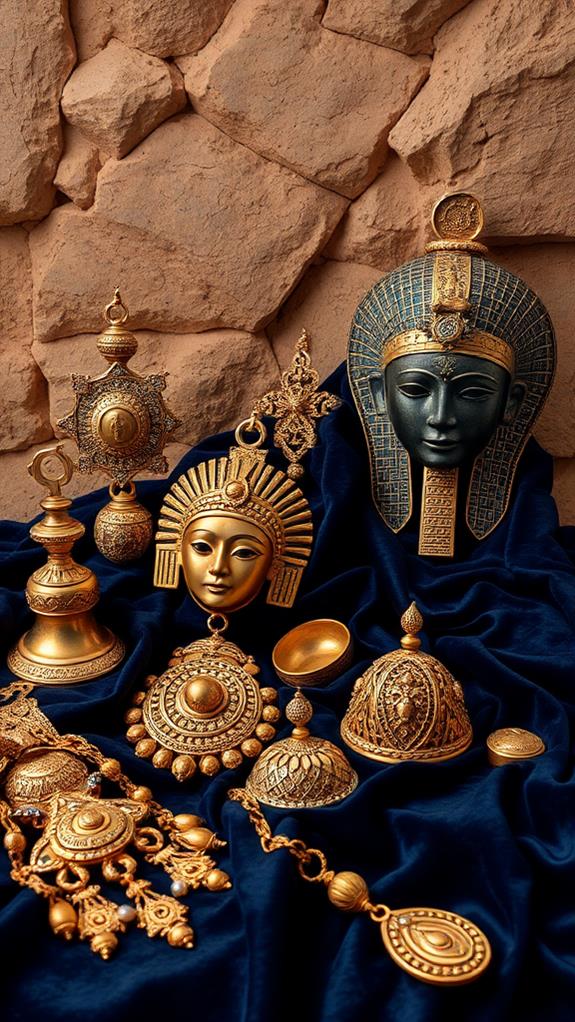
When you think of wealth in Africa, Mali might not be the first country that comes to mind. However, this West African nation has a rich history of opulence and prosperity that'll surprise you. Let's explore some Mali facts that showcase its incredible wealth.
At the heart of Mali's historical fortune was Mansa Musa, considered one of the wealthiest individuals in history. His estimated net worth of $400 billion in today's currency is mind-boggling. Mali's wealth wasn't just about one man, though. The empire thrived on its abundant gold and salt resources, making it a bustling trade hub across the Sahara.
| Resource | Impact | Legacy |
|---|---|---|
| Gold | Trade center | Economic power |
| Salt | Saharan commerce | Cultural exchange |
| Knowledge | Timbuktu universities | Scholarly attraction |
| Architecture | Great Mosque of Djenné | World's largest mud-brick building |
| Cultural diversity | Ethnic traditions | Contemporary influence |
Timbuktu, a jewel in Mali's crown, became renowned for its centers of learning. Scholars and traders flocked to its libraries and universities, cementing Mali's reputation as a knowledge hub. This legacy of wealth and wisdom continues to shape Mali's diverse cultural landscape today.
Empire of Extraordinary Proportions
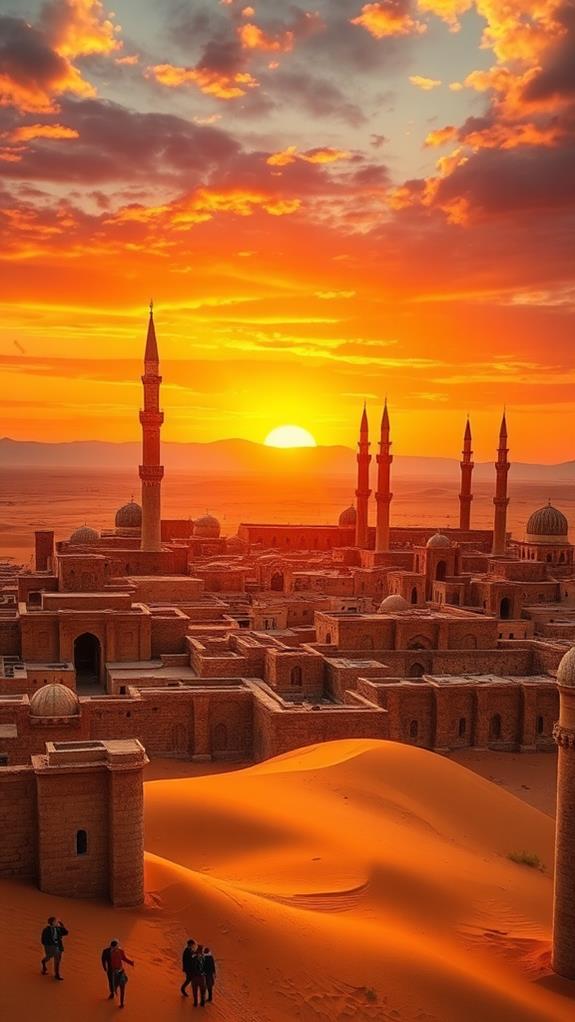
Mali's historical grandeur is epitomized by its ancient empire of extraordinary proportions. You might not realize it, but the Mali Empire was one of the largest and wealthiest in West African history. Spanning from the 1200s to the 1600s, it unified diverse Malinke kingdoms and established a sophisticated trade network across the Sahara.
Under the reign of Mansa Musa, often considered the richest man in history, Mali's wealth skyrocketed. The empire's riches, estimated at $400 billion in today's currency, primarily came from vast gold deposits. This wealth allowed Mali to flourish culturally and economically.
Imagine yourself in the heart of this empire:
- Caravans laden with gold and salt crossing the Sahara
- Scholars from far and wide converging on Timbuktu's famous university
- Merchants haggling in bustling marketplaces
- Artisans crafting intricate gold jewelry
- The Great Mosque of Djenne rising majestically, the world's largest mud-brick building
Timbuktu, the empire's capital, became a renowned center of trade and learning. It attracted scholars and merchants from various regions, cementing Mali's status as an empire of extraordinary proportions in both wealth and cultural significance.
Architectural Marvels in Mud

Mali's architectural heritage showcases remarkable structures built from mud, with the Great Mosque of Djenné standing as the world's largest mud-brick building. You'll find this UNESCO World Heritage Site at the heart of Malian culture, where the annual crépissage festival brings the community together to replaster and maintain the mosque. Another mud marvel you shouldn't miss is the Tomb of Askia, a 15th-century pyramid that blends Sahelian and Islamic styles, exemplifying Mali's rich architectural traditions.
Great Mosque of Djenné
Among Mali's architectural wonders, the Great Mosque of Djenné stands out as the world's largest mud-brick building. This impressive structure, showcasing traditional Sudanese architectural style, was originally built in the 13th century and has undergone several renovations, with its most significant reconstruction in 1907.
You'll be amazed by the mosque's unique features:
- Three towering minarets dominating the skyline
- Wooden scaffolding (toron) serving as both decoration and maintenance aid
- Adobe construction, a mixture of clay and straw
- Annual Crépisage festival for repairs and maintenance
- Central role in local religious and social life
The Great Mosque of Djenné isn't just an architectural marvel; it's a UNESCO World Heritage Site, recognized in 1988 for its historical significance and unique design in the Sahel region. You'll find thousands gathering here for Friday prayers and cultural events throughout the year. The mosque's adobe construction, a blend of clay and straw, exemplifies the ingenuity of traditional building techniques. This remarkable structure continues to captivate visitors and serve as a symbol of Mali's rich cultural heritage.
Tomb of Askia
Another architectural gem in Mali's mud-brick legacy is the Tomb of Askia. This impressive structure, built in 1495, stands as a tribute to the ingenuity of Sahelian architecture. You'll find this UNESCO World Heritage Site in Gao, a city that once held significant power during the Mali Empire.
The tomb complex isn't just a single structure; it's a multifaceted site that includes:
| Feature | Description |
|---|---|
| Pyramid | 17-meter high mud-brick construction |
| Assembly Ground | Area for gatherings and ceremonies |
| Cemetery | Final resting place for notable figures |
| Islamic Design | Reflects the region's religious influence |
| Cultural Symbol | Represents Malian history and heritage |
As you explore the Tomb of Askia, you'll notice similarities with the Great Mosque of Djenné. Both showcase the masterful use of mud bricks in Sahelian architecture. These structures demonstrate how local materials can be transformed into awe-inspiring monuments.
The tomb's recognition as a World Heritage Site underscores its importance in Islamic architecture and Malian history. It's a prime example of how traditional building techniques can create lasting landmarks that continue to captivate visitors centuries after their construction.
Annual Crépissage Festival
Prepare to be amazed by Mali's Annual Crépissage Festival, a unique celebration that transforms architectural maintenance into a vibrant community event. This festival, held in Djenné, brings together locals and tourists to renew and repair the Great Mosque of Djenné, the world's largest mud-brick building.
During the crépissage festival, you'll witness a spectacle of community spirit and traditional craftsmanship. Here's what you might see:
- Artisans mixing mud, straw, and water to create a protective layer
- Skilled craftsmen applying the mixture to the mosque's exterior
- Community members working together to preserve their cultural heritage
- Local artists showcasing traditional building techniques
- Tourists marveling at the scale and beauty of the mud architecture
This annual event not only maintains the structural integrity of the Great Mosque of Djenné but also celebrates Mali's rich cultural heritage. As a UNESCO World Heritage Site since 1988, the mosque stands as a monument to the enduring power of community and tradition. By participating in or observing the Crépissage Festival, you'll gain a deeper appreciation for Mali's unique architectural marvels and the collective effort required to preserve them.
UNESCO's Treasures in Mali

Mali's UNESCO World Heritage Sites showcase the country's remarkable ancient architectural marvels. You'll find four of these treasures within Mali's borders, including the legendary city of Timbuktu and the Old Towns of Djenné, both renowned for their unique mud-brick architecture. These sites not only represent Mali's rich cultural heritage but also serve as focal points for ongoing preservation efforts, ensuring that future generations can appreciate the country's historical significance in West African trade, education, and Islamic scholarship.
Ancient Architectural Marvels
Remarkably, Mali boasts four UNESCO World Heritage Sites that showcase its rich architectural heritage. As you explore this West African nation, you'll encounter ancient marvels that reflect the country's historical significance and cultural depth. Mali is home to architectural wonders that'll transport you back in time, including:
- The historic city of Timbuktu, once a bustling center of trade and scholarship
- The Great Mosque of Djenné, the world's largest mud-brick building
- The Tomb of Askia, featuring a distinctive 17-meter pyramid
- The Old Towns of Djenné, preserving traditional mud-brick structures
- Ancient manuscripts housed in Timbuktu's libraries
These UNESCO World Heritage Sites offer a glimpse into Mali's past, particularly its role in trans-Saharan trade. The Great Mosque of Djenné stands as a prime example of Sudano-Sahelian architecture, rebuilt annually during the Crépissage festival. This mud-brick building isn't just a religious structure; it's a demonstration of the ingenuity of ancient Malian engineers. As you wander through the Old Towns of Djenné, you'll witness the well-preserved legacy of Mali's architectural prowess, embodying the cultural richness of the Malinke civilization.
Cultural Preservation Efforts
While Mali's UNESCO World Heritage Sites stand as evidence to the country's rich history, preserving these treasures has become a significant focus for both local and international organizations. You'll find four UNESCO World Heritage Sites in Mali, each representing a unique aspect of the nation's cultural heritage. The Old Towns of Djenné, Timbuktu, and the Tomb of Askia showcase Mali's architectural prowess and historical significance.
However, these sites face significant challenges. Ongoing conflicts, including those involving Tuareg rebels, and environmental issues threaten their preservation. That's why cultural preservation efforts have become essential. International support and local community engagement play important roles in safeguarding these irreplaceable treasures.
One example of cultural preservation is the Festival au Désert, which celebrated Tuareg music and culture. Although security concerns have disrupted the festival in recent years, it exemplifies efforts to raise awareness and appreciation of Mali's diverse heritage. By promoting such events and supporting preservation initiatives, you're contributing to the protection of Mali's rich cultural legacy for future generations to explore and appreciate.
Musical Heritage at Risk
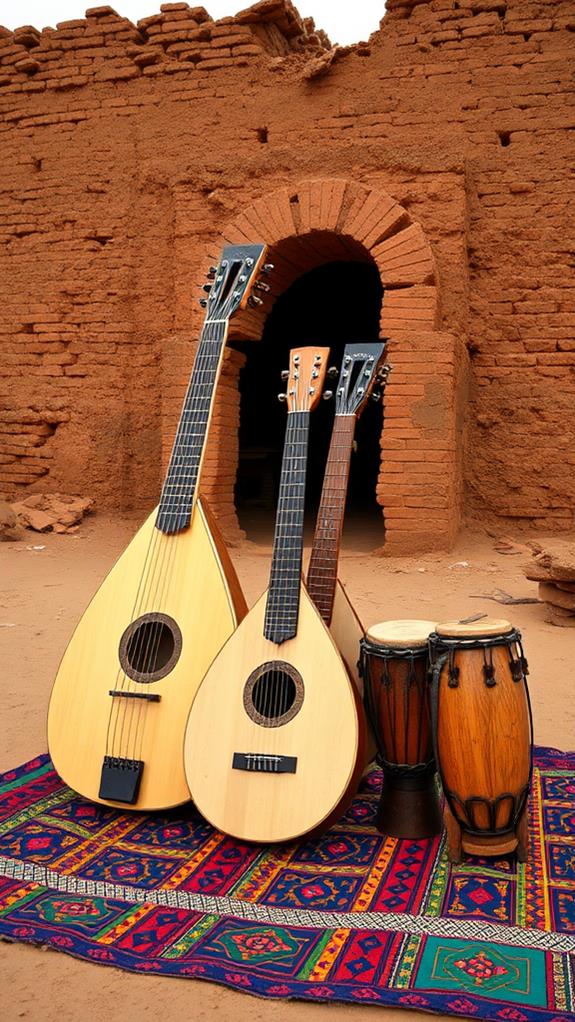
Known for its unique musical genres and rich cultural traditions, Mali's musical heritage faces significant challenges in recent years. You might not be aware that Mali's music scene, once celebrated worldwide, is now at risk due to political instability and security concerns. The country's musical landscape includes:
- Wassoulou's soulful melodies
- Tuareg desert blues
- Griot storytelling through song
- Kora and ngoni stringed instruments
- Balafon's xylophone-like rhythms
Mali's musical heritage, deeply rooted in its diverse ethnic groups, has produced internationally acclaimed artists like Ali Farka Touré and Salif Keita. However, the discontinuation of the Festival au Désert, a once-celebrated annual event showcasing Tuareg music, highlights the challenges faced by musicians in the region. This festival, which could have been a potential goldmine for the richest person in Mali, now symbolizes the broader threat to cultural expression.
The ongoing insecurity has made it difficult for musicians to perform and promote their art, potentially leading to a loss of traditional knowledge and skills. As a result, preserving Mali's musical legacy has become increasingly important, requiring innovative approaches to guarantee its survival and continued global influence.
Geographical Wonders and Wildlife
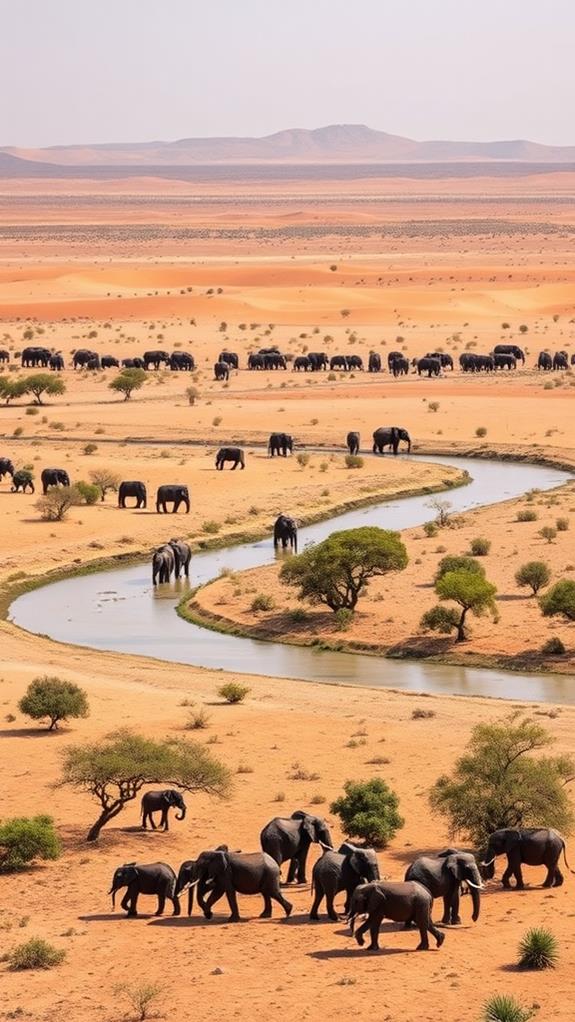
Mali's diverse landscape offers a stark contrast to its rich musical heritage. You'll find a country shaped by remarkable geographical features and unique wildlife. The Niger River, spanning over 1,000 miles within Mali, serves as a lifeline for both people and animals. It's not just a water source; it's a bustling trade route and home to diverse ecosystems.
As you explore Mali, you'll encounter dramatic changes in elevation. Mount Hombori Tondo, the country's highest point at 3,789 feet, stands tall against the backdrop of varied terrain. From the arid Sahara Desert in the north to the more fertile Sahelian region, Mali's landscape influences its biodiversity and agriculture.
The wildlife in Mali is as diverse as its geography. You'll find hippos and crocodiles thriving in the Niger River, while the Sahara hosts unique desert-adapted species. The country's climate plays an essential role, with extreme temperatures during the dry season reaching up to 113°F. A brief wet season follows, sustaining agriculture along the Niger River and supporting the diverse ecosystems that make Mali a geographical wonder.
What Makes the History of Iran and Mali Equally Fascinating?
The history of Iran and Mali is equally fascinating due to their vast cultural and intellectual legacies. From ancient Persia’s sprawling empires to Mali’s golden age under Mansa Musa, both civilizations shaped global history. Exploring interesting facts about iran unveils its pivotal role in trade, science, and art, paralleling Mali’s contributions.
Cultural Mosaic of Mali
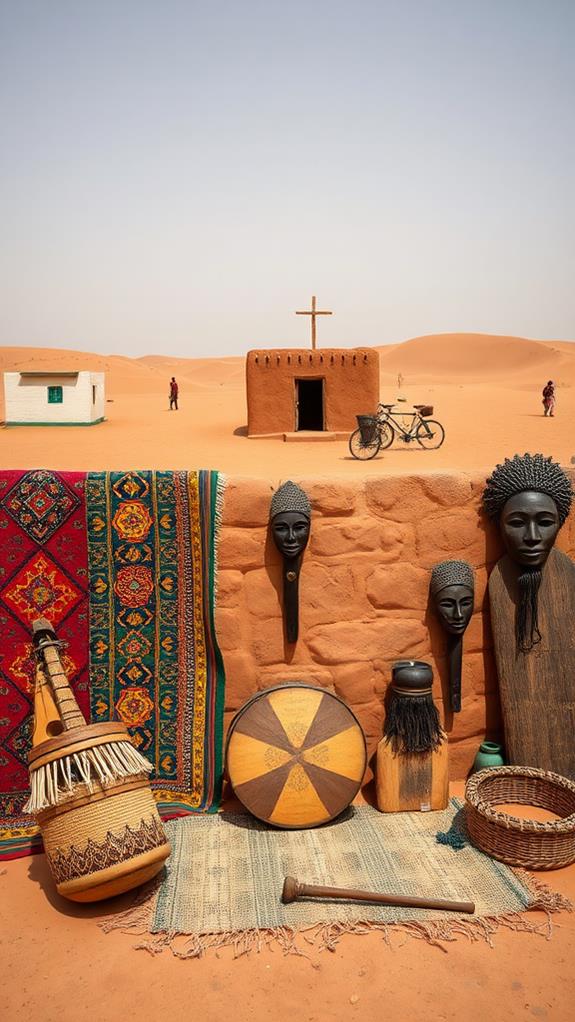
A vibrant tapestry of cultures defines Mali's social landscape. You'll find a rich mosaic of ethnic groups, including the Bambara, Fulani, Dogon, and Tuareg, each contributing to the country's cultural diversity. With over 12 national languages spoken, Bambara being the most prevalent, you'll experience a linguistic kaleidoscope that reflects Mali's complex heritage.
Mali's cultural richness is evident in its:
- Colorful traditional attire worn during festivals
- Intricate mud-cloth designs adorning textiles
- Haunting melodies of the kora, a 21-stringed harp-lute
- Rhythmic movements of traditional dances
- Aromatic spices wafting from street food stalls
You'll be captivated by Mali's musical traditions, showcased in events like the Festival au Désert, celebrating Tuareg culture. The country's cuisine is equally diverse, with dishes like Tiga Dégugué blending influences from various ethnic groups. As you explore, you'll encounter architectural marvels like the Great Mosque of Djenné, a UNESCO World Heritage site that stands as a symbol of Mali's artistic legacy. This cultural mosaic creates a unique and unforgettable experience for visitors, offering insights into the country's rich history and diverse traditions.
Frequently Asked Questions
What Are 10 Interesting Facts About Mali?
You'll find Mali fascinating with these 10 interesting facts:
- It's home to the world's largest mud-brick building, the Great Mosque of Djenné.
- Timbuktu, a historic city, houses ancient manuscripts and libraries.
- The Festival au Désert celebrated Tuareg music before security issues arose.
- Mali's Niger River stretch spans over 1,000 miles, essential for trade and fishing.
- Mansa Musa, a 14th-century ruler, is considered history's richest person.
- The country boasts diverse music styles.
- Annual Crépage festival restores the Great Mosque.
- Timbuktu symbolizes knowledge and culture.
- Mali's economy heavily relied on gold and salt trades.
- The Niger River supports numerous fishing communities.
What Is Unique to Mali?
You'll find Mali's uniqueness in its contrasts: ancient wisdom and modern challenges. The country boasts Timbuktu, a historic center of Islamic scholarship, alongside the Great Mosque of Djenné, the world's largest mud-brick building. You'll discover the Tomb of Askia, a 17-meter pyramid mausoleum, and learn that Bamako means "place of crocodiles." Mali's landlocked position at the crossroads of Arab and sub-Saharan African influences has shaped its distinctive blend of traditions and languages, making it a cultural melting pot.
What Are 3 Facts About the Kingdom of Mali?
You'll be fascinated to learn these three facts about the Kingdom of Mali:
- It was founded by Sundiata Keita in the 13th century and became one of history's wealthiest empires.
- Timbuktu, a major city in Mali, was a renowned center for trade, culture, and scholarship.
- Mansa Musa's pilgrimage to Mecca in 1324 was so extravagant, his generous distribution of gold disrupted economies along his route.
These facts highlight Mali's significant role in medieval African history and global trade.
What Did the People of Mali Do for Fun?
While you relax in your comfy chair, the people of Mali find joy in vibrant traditions. You'll discover they love music and dance, especially during festivals like the Festival au Désert. They cherish storytelling, with griots sharing historical tales and proverbs. You'd enjoy their games too, like Ludu and Dambe wrestling. Don't miss the Festival of the Niger, celebrating arts and culture. And you'd be warmly welcomed to join community feasts, savoring dishes like Tiga Déguguué while fostering social bonds.





